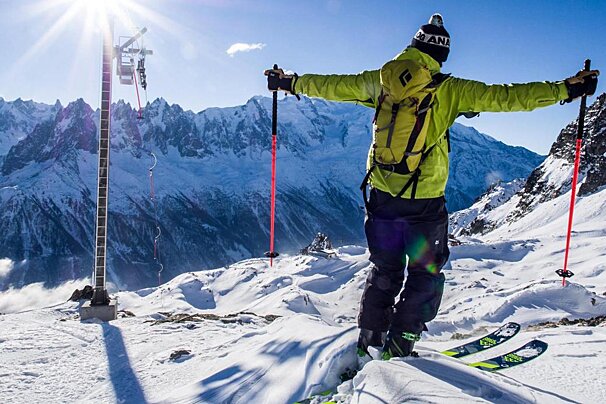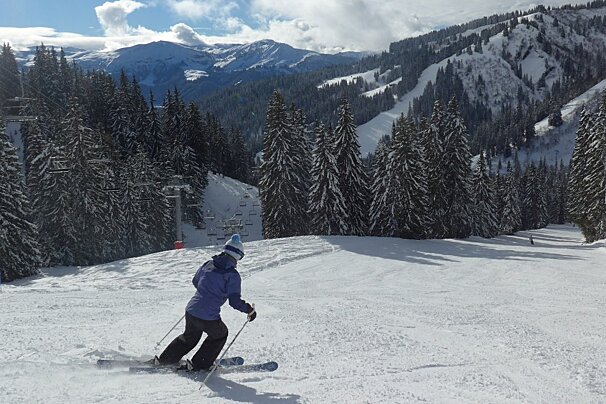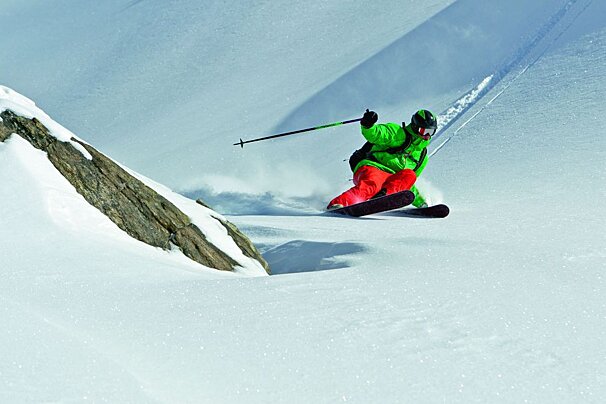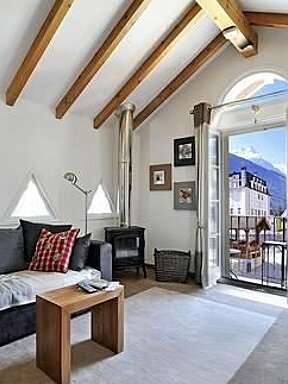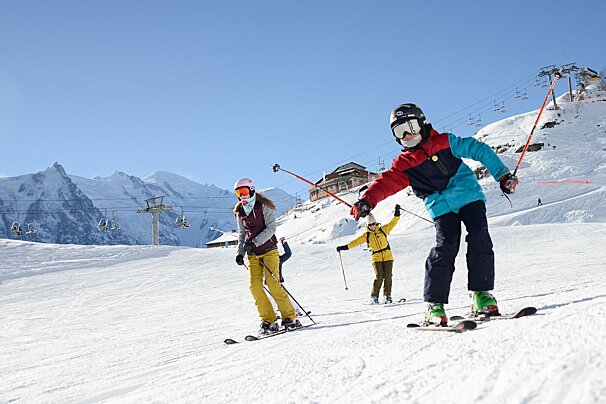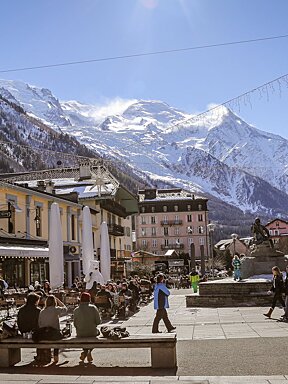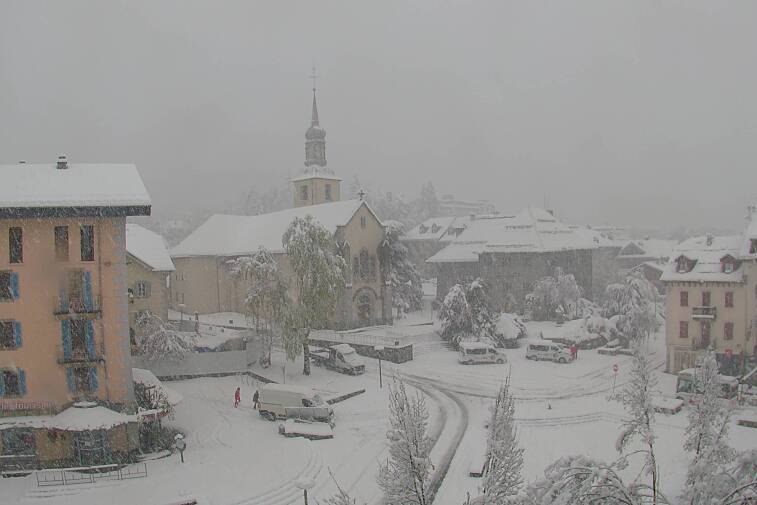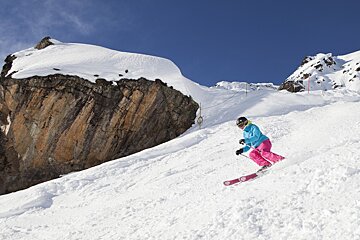
© T.Humpage
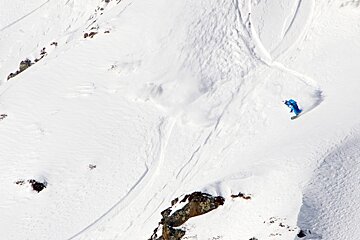
© T.Humpage
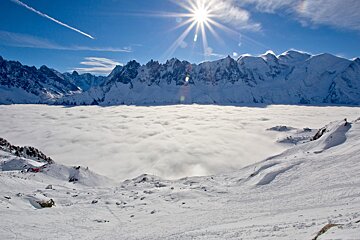
© T.Humpage
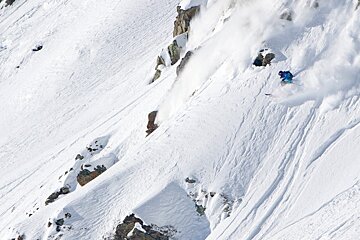
© T.Humpage
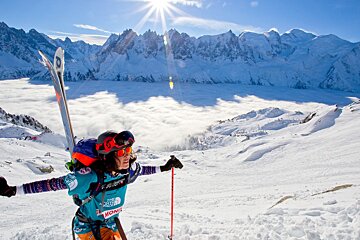
© T.Humpage
Le Brevent & La Flegere Ski Area in Chamonix
Discover the best of the Chamonix Brevent/Flegere ski area
Le Brévent and La Flégère (2,525m) on the sunny south-facing side of the Chamonix Valley are the closest skiing areas to Chamonix’s main town centre.
With some of the most scenic pistes in the valley, offering panoramic views of Mont Blanc, the Brévent and Flégère ski area has pistes to suit every style of skier (see the piste map). From long flowing groomed runs to steep skiing and even longer winding descents to the valley floor, you will find the locals up here enjoying lapping the pistes or jumping off the cat tracks on a powder day.
For many years these two areas were separate until the introduction of the Liaison cable car in 1997, linking them together to create one larger area. Access to Brévent is by a gondola just above Chamonix town, and Flégère is served by a cable car from the village of Les Praz.
Watch this

Advanced runs in Brévent and Flégère
You can check off some long runs at both Brévent and Flégère, with a possible descent of nearly 1,500m...a real thigh burner. This large ski area offers you a whole host of steep and challenging runs and plenty of lifts so you can scoot up and down the pistes all day long.
Brévent
The Charles Bozon black run from the top of the Brévent cable car takes you all the way to the valley floor if you link up the various runs. In good snow conditions it’s possible to combine the Charles Bozon with the Nants run all the way back down to the valley floor to clock up nearly 1,500m of vertical descent.
At the start of the Charles Bozon run there are two variants; one that offers steep moguls for those on a mission to prove their skiing credentials, or one that’s slightly more sedate and zig-zags down the cat tracks for the more cautious skier amongst us. Both lead to the Planpraz area where you can then select from a host of easy blue runs that lead to the bottom of the Parsa and Cornu chairlifts, and to where the Nants (home run) black run starts. The Nants piste is a zig-zag cat track that takes you all the way down to the bottom of the Plan Praz bubble lift and even down into the centre of Chamonix.
Of all the blue runs our favourite is Blanchots, it’s the least travelled, is slightly shadier and often has the best snow.
Flégère
Lachenal is a superb red with a very steep and narrow upper section (we think it's slightly harder then most reds). This run is often very well groomed so you’ll be unlucky to find moguls on it, you’ll generally find it smooth and fast. The lower section flattens out as it approaches the tree line where it joins Evettes; follow this blue run towards the Evettes chair. From here you can either take the old rickety chair back up to the main ski area, or combine Lachenal with the home run and take a right onto Praz just before the chairlift. Giving you a descent of 1,300m, again this is a zig-zagging black cat track through the trees, but halfway down it opens out into a wide chute where you can head straight down to Les Praz and the cable car at the bottom of the valley. It’s only worth doing when the snow is good and in the morning before the crowds start to make the return journey home at the end of the day. The snow melts off here quickly, so it won't be open/worth it in late Spring.
Floria is a black piste highly rated by the locals because of the vast amount of off-piste it delivers and in the right conditions it's a dream to come down. It is however serviced by a clunky drag lift of the same name and is often closed in bad weather due to the high avalanche risk from the peaks above. But if it's open it's one not to be missed, especially on a powder day and/or if it's been closed for a while as it often remains unpisted. Take the Index chairlift and head over to skiers' right. This long and challenging black will eventually take you down to the Trappe chair.

Bad Weather areas in Brévent and Flégère
In bad weather there are much better places to head to over Brévent and Flégère, so we'd recommend you look elsewhere for places to ski when the flakes are falling, or simply stay in bed and rest up for tomorrow's potential powder day.
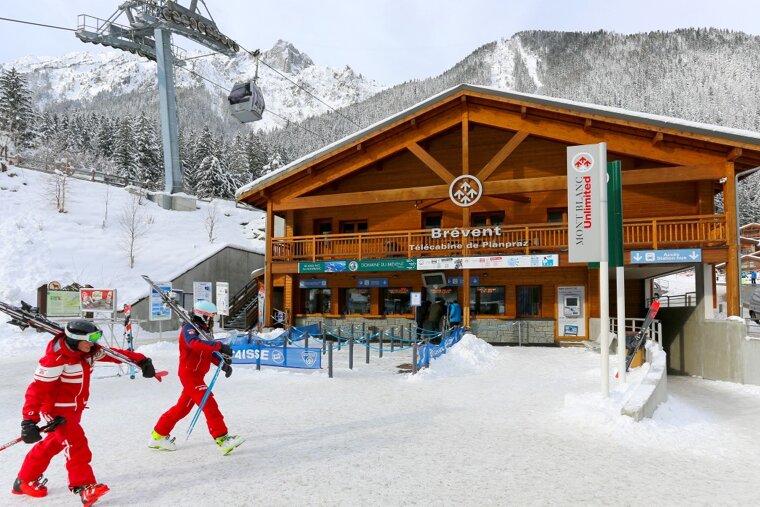
Beginner areas in Brévent and Flégère
If you're a complete beginner skier or snowboarder, head to the Savoy nursery area, or if you've left ski school and are looking to practise on the main pistes, then there are a total of four green pistes and 11 blue pistes to explore, between the two ski areas.
Brévent
A mini-funicular the 'Funi 2000' allows beginner skiers and snowboarders easy access from the main gondola straight to the green pistes. Here you'll find the highest altitude green run in Chamonix called 'Verte 2000'. This piste is fairly short (275m) and is served by its own drag lift, making it easy to do lots of practise laps.
The other green piste is the 'Retour Plan Praz', which takes you back to the Plan Praz gondola to get back down to resort or onto the blue piste that links back to the bottom of the Parsa chair lift.
Blue pistes 'Vioz' and 'Blanchots' are also access by the Parsa chair and are great for those who are able to link turns and would like more of a challenge, as they offer longer runs and slightly steeper slopes to practice on. The Sources and the Charnalon chairlifts link to the remaining blue pistes in this area.
Flégère
The Trappe chairlift at the top left of the Flégère cable car serves two gentle green pistes, the 'Trappe' and 'Libellules'. These pistes are a little longer than the ones at Brévent and being just at the top of the tree line, they have some pretty impressive views across the valley to the Aiguille du Midi and Mont Blanc. Libellules is also a fun-zone, with banked corners, arches to ski under and small snowpark features to play on.
If you feel you have progressed from skiing green pistes, you can try 'Chavanne' blue piste from the top of the Chavanne chair lift, or try the 'Retour Flégère' blue piste which will take you back to the Flégère cable car, where you can then take the lift down to get back to the valley floor. 'Evettes' blue piste takes you over the the liaison cable car with Brevent, or you can lap the Evettes chair lift and enjoy this wide, traversing piste.

Best pistes in Brévent & Flégère
Skiers and snowboarders are guaranteed to find something to their liking from the vast array of moderate, challenging and difficult runs from the top of Planpraz (Le Brévent), Cornu (Le Brévent) and Index (La Flégère) chairlifts. The view from these ski runs over towards Mont Blanc and the Aiguille du Midi are truly spectacular.

Off-piste skiing in Brévent and Flégère
The locals favourite, the Brévent and Flégère ski areas offer some great terrain for off-piste skiing, with steep couloirs and natural bowls that are surprisingly easy to access. As with all off-piste riding, you should be equipped and know what you're doing.
Brévent
One favourite off-piste area is the ridge at the top of Brévent, which requires a little bit of hiking, but then gives you the option of dropping into various steep chutes above the Charles Bozon piste. The steepness of these chutes makes them avalanche prone so take care. Falling here could result in a drop over cliffs, or an avalanche that could take out skiers below.
You get to this area by taking the top Brévent cable car and then following the Bozon run down until it turns sharply to the right. Here, take a left under the avalanche warning rope; passing this means you need to be responsible for yourself and others, be equipped and know what you’re doing. Following the ridge, there are a few sections that go uphill and so you'll have to walk a little bit. Depending how far you go there are various narrow couloirs that drop down to the right. After a 10-15 minute hike along the back of the ridge you reach the Col de Brévent, an open col with views on the right down to the Bozon piste and Chamonix Village immediately below - another one of our favourite runs with plenty of steep and deep stuff to amuse you.
The snow is usually good here for a few days after a fresh dump but will get unstable if the sun gets to work on it and the temperature rises, so you shouldn't do this run late in the afternoon on warm days. In the spring you’ll see the pisteurs setting off controlled avalanches on these slopes.
Flégère
The terrain of Flégère is also superb for off-piste skiing. The main bowl offers some of the best freeride terrain that Chamonix has on offer. The natural undulating terrain makes it great for natural table tops, quarter pipes and half pipes and in fact, the whole bowl is pretty much rideable with only a few exceptions. The snow often remains very good at this altitude, however, it is good to stay alert as this section has hidden rollovers, some of which lead onto very large cliff drops so we recommend that you don’t go skiing over things before you’ve checked where they go. Only enter this off-piste area in good visibility and once you already have a good idea of where you are going.
Route 1: Combe Lachanel - On a fresh powder day, it is best to try and catch the first cable car up from Les Praz to get those all important first tracks. The Index chairlift makes getting into the Combe Lachenal easy, as it drops you right at the top of the bowl. Take a left (skier’s right) from the chairlift into the bowl, pay attention to any warning barriers as this area is avalanche prone. Make sure you are fully equipped, trained and avalanche aware.
The bowl is vast with only one piste running down the middle. You can select to traverse out either left or right to get fresh tracks, and generally, it takes a long time before this bowl is truly tracked out. If you traverse out skiers’ right be sure not to go so far that you can’t get back to the piste at the bottom that will take you back to the Evettes chairlift (you may find yourself heading down to Les Praz via the main avalanche chute if you stray too far off the beaten track!).
If you traverse left about halfway down you’ll find a small hidden bowl that keeps the ‘freshies’ longer than the main bowl. The terrain is great for freeriding with wide open sections at the top. Lower down there are small chutes and drops to the right, rollers and trees to the left.
Route 2: The Index - The area to the right (skier’s left) of the Index chairlift also has some superb off-piste with longer runs possible. Head out below the old Index lift building and work your way down the mountain. Along here you’ll find cornices where you can drop in, and wide open slopes where you can let rip before heading down towards the Trappe chairlift that takes you back to the Index lift.
Route 3: Floria - The area between the Floria piste and the Pylones piste is a massive ungroomed area that has enough excitement to keep you coming back run after run, each time discovering another hidden stash of fresh snow. You can also access some of the great off-piste conditions to the right of the Index chair by using access from the bottom of the Floria lift. We would reiterate that we are extremely careful in this sector above the Chavanne chairlift as this area has many roll overs as we discussed above, some of which lead to large cliff drops. Make sure you can see your route down the mountain before you take off at top speed.
Route 4: The Trappe - If you’re trying off-piste for the first time, the area under the Trappe chair has some fun terrain. Trees and good snow will give you a very nice taste of the off-piste without straying too far from the green runs.
Above the Trappe green run, there are a couple of steep, narrow couloirs visible to the right as you get to the top on the ride up the Trappe chairlift. They start out wide and flat but quickly become steep and narrow, so probably best not attempted if the snow is hard and icy, but in good snow they offer a real buzz and are a true technical test of your ability. We get to these from the Pylones piste, by heading skier's left just before you get to the flat section near the bottom of the run.

Backcountry routes in Brévent and Flégère
Some of the most popular ski touring routes in the Chamonix valley begin from the top of the Index chairlift at Flégère. They involve a fair bit of mountaineering knowledge as well as off-piste skiing and avalanche safety techniques. La Flégère and Le Tour/Balme, a little further up the valley, are known locally as having some of the best natural terrain for freestyle, with gullies that form natural half pipes, rollers, cornices and jumps everywhere you look.
These are just a few suggested routes for backcountry touring from Flégère. They're far from comprehensive but offer a taster of what’s possible if you want to stray from the regular pistes. Most of our routes finish in Le Buet, which is at the foot of the Bérard valley. From Le Buet, you can catch a train back to Chamonix or take the Vallorcine lift if you fancy skiing further and exploring the Le Tour/Balme lift system.
There are several excellent guidebooks with descriptions of the many possible routes both within and beyond the lift areas. There are two published by Vamos called Mont-Blanc Ski tours (ISBN 2910672085) and Chamonix Hors Pistes-Off piste (ISBN 2910672107); these books are bilingual, in English and French. An even more extensive guidebook with more difficult routes is Mont-Blanc et Aiguilles Rouges à ski (ISBN 2960025520), written by Anselme Baud and published by Nevicata; it’s only available in French but is worth struggling through even if your French isn’t so good as it gives very accurate descriptions and has good explanatory photos. But remember, in the backcountry there are many dangers not least from cliffs and avalanches so you should always hire a Chamonix guide.
If hiking isn’t your thing but you love powder then heli-skiing/boarding could be for you. Whilst helicopter drops of this nature are illegal in France (as you land on National park), Chamonix is well located with plenty of companies offering heli-drops on the Mont-Blanc massif just over the border in either Switzerland or Italy.
The Col des Crochues at Flégère gives access to the Col de Bérard (easiest), Bérard Breche and Glacier Mort (hardest) routes. Take the cable car up from Les Praz, the Index chair and then the Floria drag lift. From there the Col des Crochues looks right up the hill. The skin to the top takes on average 40 minutes for those with a good level of fitness. The top section becomes quite steep so you'll need to boot pack up this (it’s not normally necessary to use crampons in this section). On warm spring days, this climb can be prone to wet snow slides so this route is best done early in the morning.
Route 1: Col de Bérard
For the Col de Bérard it’s a long traverse skiers right from the Col des Crochues. You should try to stay as high as possible on the traverse until you reach the flat section and can go no further. Something to watch out for on the traverse is the avalanche risk from the slopes above. These slopes catch the sun and warm up causing inevitable slides onto the traverse below, and if caught in one of these slides you could possibly be carried over the cliffs that sit below some sections of the traverse. If you take this traverse too early in the morning it can also be icy and difficult, so the trick is to catch it just as it’s softening up. From the flat section you can put on your skins and head right to the Col; a relatively short hike of 15-20 minutes to the Col de Bérard. You can often expect good snow in the Bérard Valley as its slopes are not too steep and the route down is fairly straight forward. Continue following the valley down until you reach the trees and river which lead out of the valley towards Le Buet. If you do this route on a snowboard you may find the last section by the river is a bit of a drag as there are short uphill sections where you may have to walk. The path by the river leads all the way down to Le Buet where the Le Buet Hotel offers a rest stop for a well-deserved beer.
Route 2: Bérard Breche
The Bérard Breche hike is quite a bit longer than the Col de Bérard so should only really be attempted if you’re feeling pretty fit. Instead of going to the skiers’ right of the Col des Crochues, you need to climb the ridge to the North. Continue down into the small valley below the flat area before commencing the hike up the facing wide gully, and following on above to the open slopes that lead to the Petite Aiguille de Bérard. From there follow the ridge that leads up to the right in the direction of Breche. Near the top, traverse below the ridge to reach the rocky notch, which is the Breche. As you climb up through the notch you’ll see the Bérard Valley below. It’s a demanding hike of about 90 minutes but delivers you almost to the very top of the Bérard Valley and offers a longer descent than the Col de Bérard described above. On the route down beware of the cliff directly below the Breche, you can traverse skiers’ left to avoid it. The rest of the route is open with rolling terrain down to the bottom of the valley where the route out is the same as for the Col de Bérard.
Route 3: Glacier Mort
For Glacier Mort (translated as 'dead glacier'), take the traverse from the Col des Crochues but stop halfway along the traverse and climb the large couloir on the right towards the Point Alphonse Favre. For the lower part of the climb you may need skins or snowshoes, but from halfway up where it gets steeper boot packing is better. At the top of the couloir follow the rocky ridge up to the right. The rocks provide good hand holds on the last steep pitch, however if it is icy, crampons are highly recommended. This climb can be intimidating due to the steepness of the latter sections, and also because it was the toughest of the three, but if you’re looking for some great powder, the last little steep slog is definitely worth it. From the top, (which can be cold and windy even on warm days), traverse to the right to avoid the rock band below and then traverse back left below the rocks to the top of the open gully below. The terrain here is superb with most of it shady and protected from the sun. Follow the gully down, making the most of its powder until it opens out from where you follow the valley down to meet the river and trees for the exit to Le Buet.
Other popular routes in the area include hiking out to Lac Blanc where you can head into the Bérard Valley via the Col de Belvedere (although be sure to bring the appropriate kit with you as there is some abseiling required) and the Col de Beugeant.
It’s always recommended that you take a mountain guide when you do these routes. Mountain guides have the best knowledge of the snow conditions and dangers involved including the avalanche risks at the time. A guide will make sure that you ride the best snow possible and pick a route that is most suitable for your group.
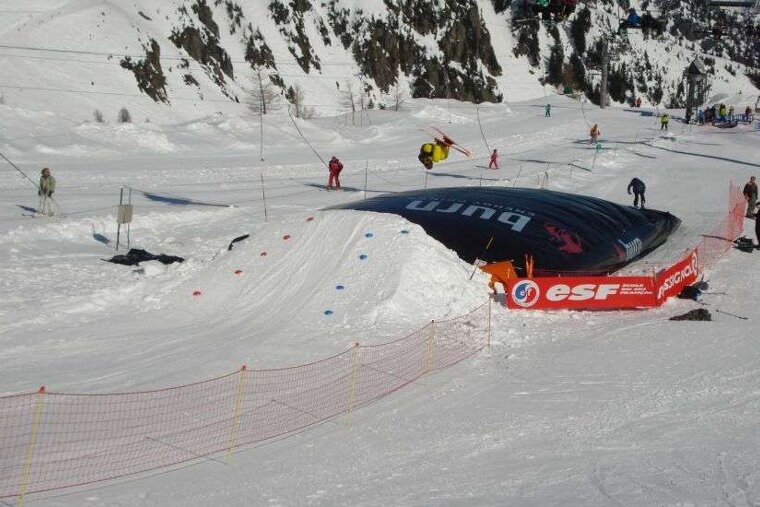
Snowparks in Brévent and Flégère
Whilst this area has endless natural hits you can play off, there's no actual park here, but there is a kicker with an airbag next to the beginner slope.
Over on the Brévent side of the valley, there is often a small boardercross area which is mostly maintained during peak holiday periods. You'll find it by turning off to the right about a third of the way down the Cornu piste.
The big air bag and a set of rails are located just under the Parsa chairlift. So if you want to practise before you take on the big kickers in Le Tour then check this out.
More inspiration...
Take a look at this year's Ski Pass Prices or, if you're not sure which pass to buy, read Ski Pass Options for more information. Find your way around with Piste Maps for Chamonix.








